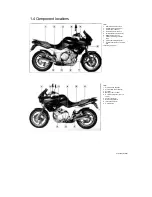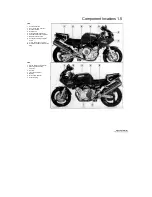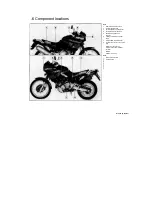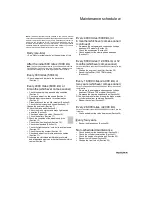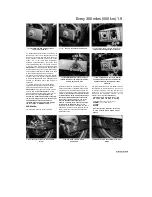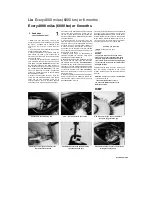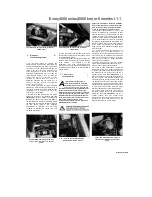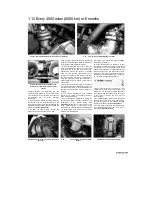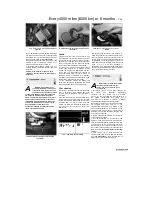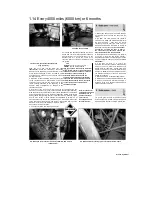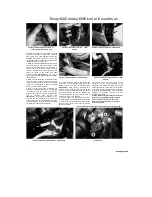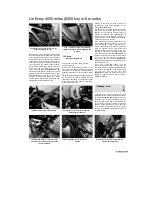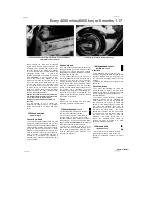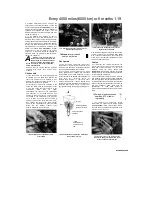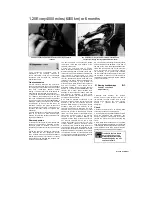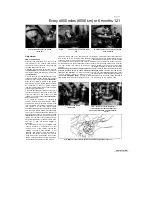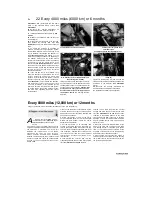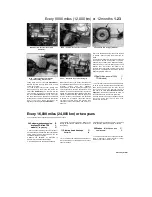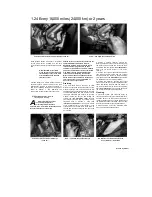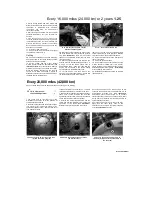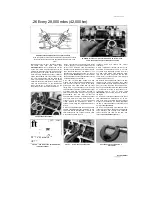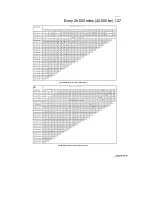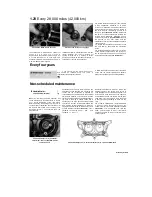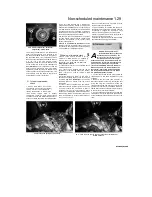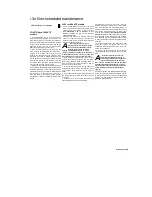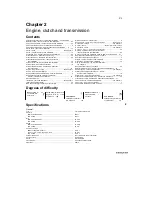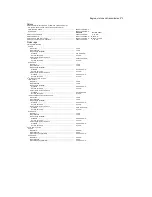
RSIOH OF PICTURE-DESK~|
1.18 Every 4000 miles (6000 km) or 6 months
2 Pay particular attention to the following:
Sparkplugs
Engine oil drain plugs
Gearchange lever, brake and clutch lever,
and brake pedal bolts
Footrest and stand bolts
Engine mounting bolts
Shock absorber and suspension linkage
bolts and swingarm pivot bolts
Handlebar clamp bolts
Front axle bolt and axle clamp bolts
Front fork clamp bolts (top and bottom
yoke)
Rear axle nut
Brake caliper mounting bolts
Brake hose banjo bolts and caliper bleed
valves
Brake disc bolts
Exhaust system bolts/nuts
3 If a torque wrench is available, use it along
with the torque specifications at the beginning
of this and other Chapters.
16 Cooling system - check
§§>
i|
Warning: The engine must be cool
before beginning this procedure.
1
Check the coolant level (see
Daily
(pre-ride) checks).
2 The entire cooling system should be checked
for evidence of leakage. Examine
each rubber coolant hose along its entire length.
Look for cracks, abrasions and other damage.
Squeeze each hose at various points. They
should feel firm, yet pliable, and return to their
original shape when released. If they are dried
out or hard, renew them.
3 Check for evidence of leaks at each cooling
system joint. Tighten the hose clips carefully to
prevent future leaks.
4 Check the radiator for leaks and other
damage. Leaks in the radiator leave tell-tale
scale deposits or coolant stains on the outside of
the core below the leak. If leaks are noted,
remove the radiator (see Chapter 3) and have it
repaired or renew it.
Caution: Do not use a liquid leak stopping
compound to try to repair leaks.
5 Check the radiator fins for mud, dirt and
insects, which may impede the flow of air through
the radiator. If the fins are dirty, remove the
radiator (see Chapter 3) and clean it using water
or low pressure compressed air directed through
the fins from the rear side. If the fins are bent or
distorted, straighten them carefully with a
screwdriver. If the air flow is restricted by bent or
damaged fins over more than 30% of the
radiator's surface area, renew the radiator.
6 To access the radiator pressure cap and filler,
on TDM models, remove the right-hand fairing
side panel, on TRX models remove the fairing,
and on XTZ models remove the left-hand fairing
side panel (see Chapter 8). On TRX models,
remove the security bolt holding the radiator cap
(see illustration).
Remove
the pressure cap from the radiator filler neck by
turning it anti-clockwise until it reaches a stop
(see illustrations).
If you hear a hissing sound
(indicating there is still pressure in the system),
wait until it stops. Now press down on the cap
and continue turning the cap until it can be
removed. Check the condition of the coolant in
the system. If it is rust-coloured or if
accumulations of scale are visible, drain, flush
and refill the system with new coolant (See
Section 27). Check the cap seal for cracks and
other damage, if in doubt about the pressure
cap's condition, have it tested by a Yamaha
dealer or renew it. Install the cap by turning it
clockwise until it reaches the first stop then push
down on the cap and continue turning until it can
turn further.
7 Check the antifreeze content of the coolant
with an antifreeze hydrometer. Sometimes
coolant looks like it's in good condition, but might
be too weak to offer adequate protection. If the
hydrometer indicates a weak mixture, drain, flush
and refill the system (see Section 23).
8 Start the engine and let it reach normal
operating temperature, then check for leaks
again. As the coolant temperature increases
beyond normal, the fan should come on
automatically and the temperature should begin
to drop. If it does not, refer to Chapter 3 and
check the fan switch, fan motor and fan circuit
carefully.
9 If the "coolant level is consistently low, and no
evidence of leaks can be found, have the entire
system pressure checked by a Yamaha dealer.
17 Throttle and choke cables - §*>
check
H
Throttle cables
1 Make sure the throttle grip rotates easily from
fully closed to fully open with the front wheel
turned at various angles. The grip should return
automatically from fully open to fully closed when
released.
2 If the throttle sticks, this is probably due to a
cable fault. Remove the cables (see Chapter 4)
and lubricate them (see Section 18). Install the
cables, making sure they are correctly routed. If
this fails to improve the operation of the throttle,
the cables must be renewed. Note that in very
rare cases the fault could lie in the carburettors
rather than the cables, necessitating the removal
of the carburettors and inspection of the throttle
linkage (see Chapter 4).
3 With the throttle operating smoothly, check for
a small amount of freeplay in the cable assembly,
measured in terms of the amount of twistgrip
rotation before the throttle opens and the pull of
the cable is felt; compare this amount to that
listed in this Chapter's Specifications
(see
illustration).
If it's incorrect, adjust the cable
assembly to correct it.
OF PICTURE-DESK
Staned by Stalker
UNREGISTERED VERSION OF PICTURE-DE
A
16.6a On TRX models, remove the
pressure cap security bolt (arrowed)
16.6c Pressure cap (arrowed) -
XTZ models
16.6b Pressure cap (arrowed) -TDM
models
17.3 Measure the amount of freeplay at the
throttle grip flange
Содержание XTZ750
Страница 174: ...UNREGISTERED VI ScanedbyStalker UNREGISTERED VI ...
Страница 207: ...Wiring diagrams 9 29 _____Scaned by Stalker 5 l 6o Cxj fi I JICM ...
Страница 208: ...UNREGISTERED VI 9 30 Wiring diagrams UNREGISTERED VERSION 01 ONREGISTEREDVI Scaned by Stalker ONREGISTERED VERSION 0 ...
Страница 209: ...I UNREGISTERED VI Wiring diagrams 9 31 ____ Scaned by Stalker UNREGISTERED VERSION OF PICTURE DESK ...
Страница 210: ...9 32 Wiring diagrams Scaned by Stalker ...
Страница 211: ...XTZ750 gauge Starter circuit Neutral Starter cut off relay switch rnotor ...

